There is an old joke in SEO circles.
Question: Where do you hide something you don’t want found?
Answer: Page 2 of Google’s search results.
Groan-worthy humor aside, the joke highlights an important reality for any ecommerce brand that wants to get found online. In an era where 51% of online traffic comes from organic search, optimizing your ecommerce site to perform well in search results is a necessary – not optional – part of your growth and marketing strategy.
What does SEO look like for ecommerce brands?
Let’s start with a quick definition of SEO, or Search Engine Optimization.
SEO is the process of optimizing your current site to drive more organic or ‘free’ traffic from search results on search engines.
Why the focus on search? Consider these stats from imFORZA:
- 70% of the links search users click on are organic
- 75% of users never go past the first page of search results
- SEO leads have a 14.6% close rate vs the 1.7% for outbound leads
The takeaway: organic search traffic can drive qualified leads to your site and improve your conversions, but to snag those wins, your site needs to show up well in search results.
That is where SEO comes in. It is a vital part of getting your site in front of interested, motivated customers.
While there are a variety of SEO tactics, we are going to focus on the quick and powerful wins from including high value keywords in your copy.
Growing your ecommerce brand with high value keywords
When you are optimizing your site, it is critical to remember that you are writing for two audiences: search engines and potential customers.
Search engines want to understand what your page is about, so they can deliver relevant results to searchers. And potential customers are more likely to turn into buyers if they land on a product page that matches their search terms.
Both groups rely on the keywords in your titles, meta descriptions, and page copy to guide them.
Below is an example of how search keywords are reflected on the search engines results page.
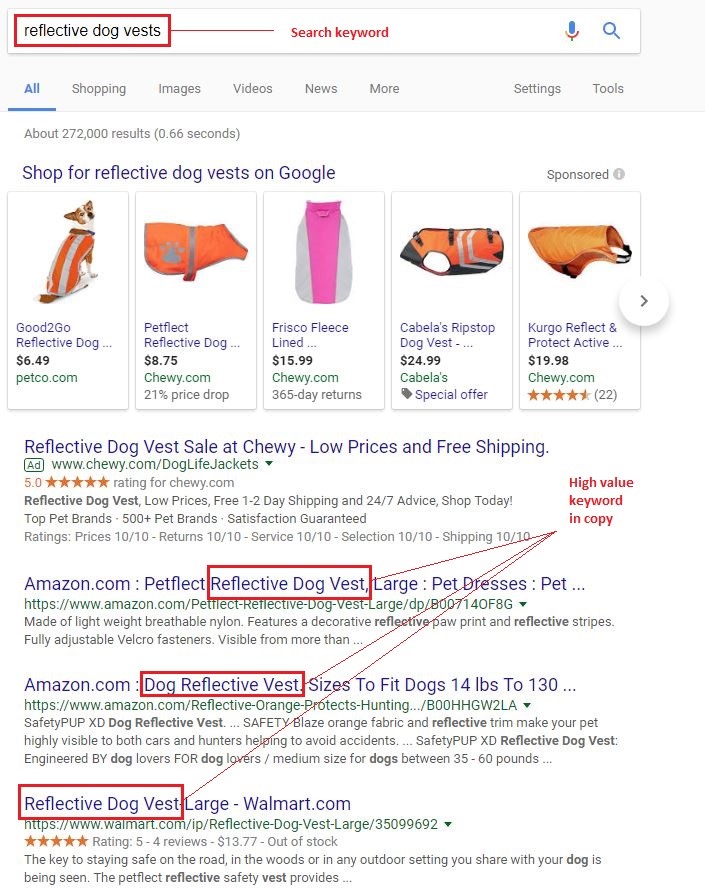
That is why a successful SEO strategy starts with finding the most relevant, high value keywords for your site and audience.
But first, what is a high value keyword?
A high value keyword is a word or phrase that has high search volume and high relevance to your ecommerce product catalog.
For example, if you sell kitchen tools and appliances, which of the keywords below qualify as high value?
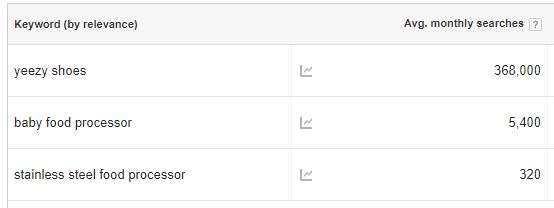
Stainless steel food processor is relevant, but has low search volume. Yeezy shoes has high search volume, but no relevance to your product catalogue. Baby food processor has both high search volume and relevance, which means it could be a high value keyword for you.
To identify these high value keywords, it is important to understand how your customers are searching for products.
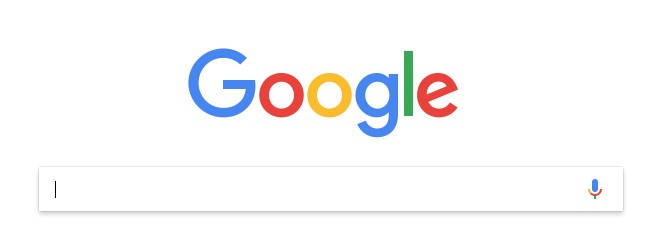
The key to reaching your customers? Speak their language
Customers use many different terms to describe what they are looking for. Brands that zero in on the wrong one could leave valuable traffic on the table.
Case in point: women’s pants come in a variety of styles – skinny, wide leg, straight leg, etc. Here we see Nordstrom and Macy’s are targeting the keyword high rise in their collection pages. Pretty specific, right?
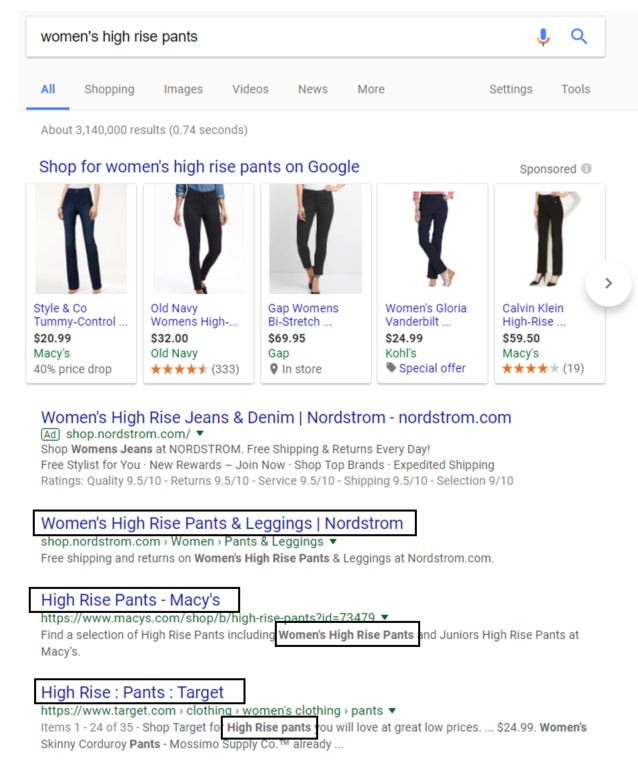
But that is only part of the picture. The more common buzzword for this style is high waisted pants. And it is not just a buzzword. The search volume numbers show it is a popular search term, too.

There are 1,600 average monthly searches for high rise pants versus the 33,100 average monthly searches for high waisted pants.
Both search terms are specific – perfect for driving qualified buyers to a site. But one targets a significantly larger group of shoppers. That means Nordstrom and Macy’s are limiting their traffic – and therefore sales – opportunities because of their keyword choice.
3 easy keyword updates to jumpstart your SEO efforts
Now that you have a better understanding of how customers are searching for your products, what’s next?
It is time to optimize the content on your website to bring in qualified buyers.
Concentrate your efforts on optimizing these three areas:
- Page titles
- Page copy
- Meta descriptions
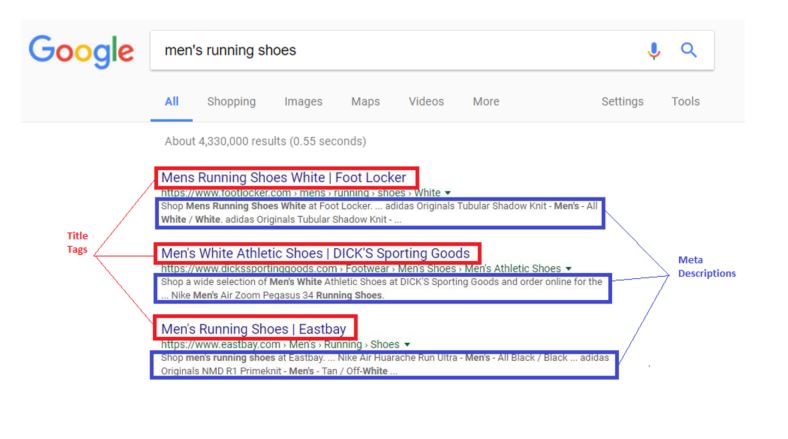
Using multiple, relevant, high value keywords that explain product features in these key spots will improve your product pages’ ability to (1) show up in search results (2) attract users who are searching for a specific product.
Page titles – the signposts of the internet
Even though we are focusing on titles for collections pages and product pages, these guidelines can apply to the title for any page across your site.
There are four components to building high impact titles:
- Keyword placement: Put your high value keywords first in the title, followed by less important (but still relevant!) keywords.
- Relevancy: Titles must be relevant to the content on the page, otherwise you’ll have a high bounce rate (i.e. the percent of visitors who leave – or ‘bounce’ away from – your site after just viewing one page). Not only do inaccurate titles hurt your brand image, but a high bounce rate can lead search engines to penalize your site, pushing it further down in search results or obscuring it entirely.
- Branding: Add your brand name at the end of the title to increase brand awareness. If you’ve built up brand awareness, it may drive more visitors to your site.
- Never ‘keyword stuff’: Don’t overload your titles with repetitive or excessive keywords. It looks spammy and can lead to blacklisting from search engines.
This collections page title from REI is a great example of a strong title. It starts with the high value keyword, followed by additional relevant keywords to draw the viewer in. REI has built solid brand awareness, so including the company name in the title will likely drive additional qualified traffic.

Collections page titles
People often search for products by a unique product feature. Collections pages are a great opportunity to capitalize on these search terms and drive organic traffic to a page showcasing multiple items that match the unique product feature.
For example, if a user is searching for a new watch, they may be looking for a unique product feature, like rose gold. But online retailers could have numerous products with that unique product feature. Instead of trying to guess which products your customers will like most, a collections page showcases the multiple products matching your customer’s search term.

Product page titles
Product page titles are your opportunity to connect with some of the most valuable, motivated customers on the internet: people looking for specific products. They are also your opportunity to stand out from the competition.
The more relevant and specific your product page titles are, the more likely a motivated buyer is to click on your page.
Consider these results for the search term women’s lightweight travel vests quick drying. While both meta descriptions include a reference to the product’s quick dry capabilities, only one title tag does.
If you were searching for a new quick dry travel vest, which result would you click on?

Create page copy that shines in search and conversions
Just like titles, your product page copy can improve your rank in search results and drive click throughs (to checkout).
While your on-page product title and description are the perfect place to start adding your high value keywords, we encourage you to think beyond the typical, above-the-fold product description.
Does your product have (or need) a ‘How-To’ or miniature FAQ section? Are there relevant product details – care and maintenance, material or component details, etc. – that your customers would find useful?
These frequently overlooked product page sections can help you naturally incorporate more high value keywords into your copy, without sounding like a robot or stuffing your page with keywords. Aim for 4-5 high value keyword placements on your page.
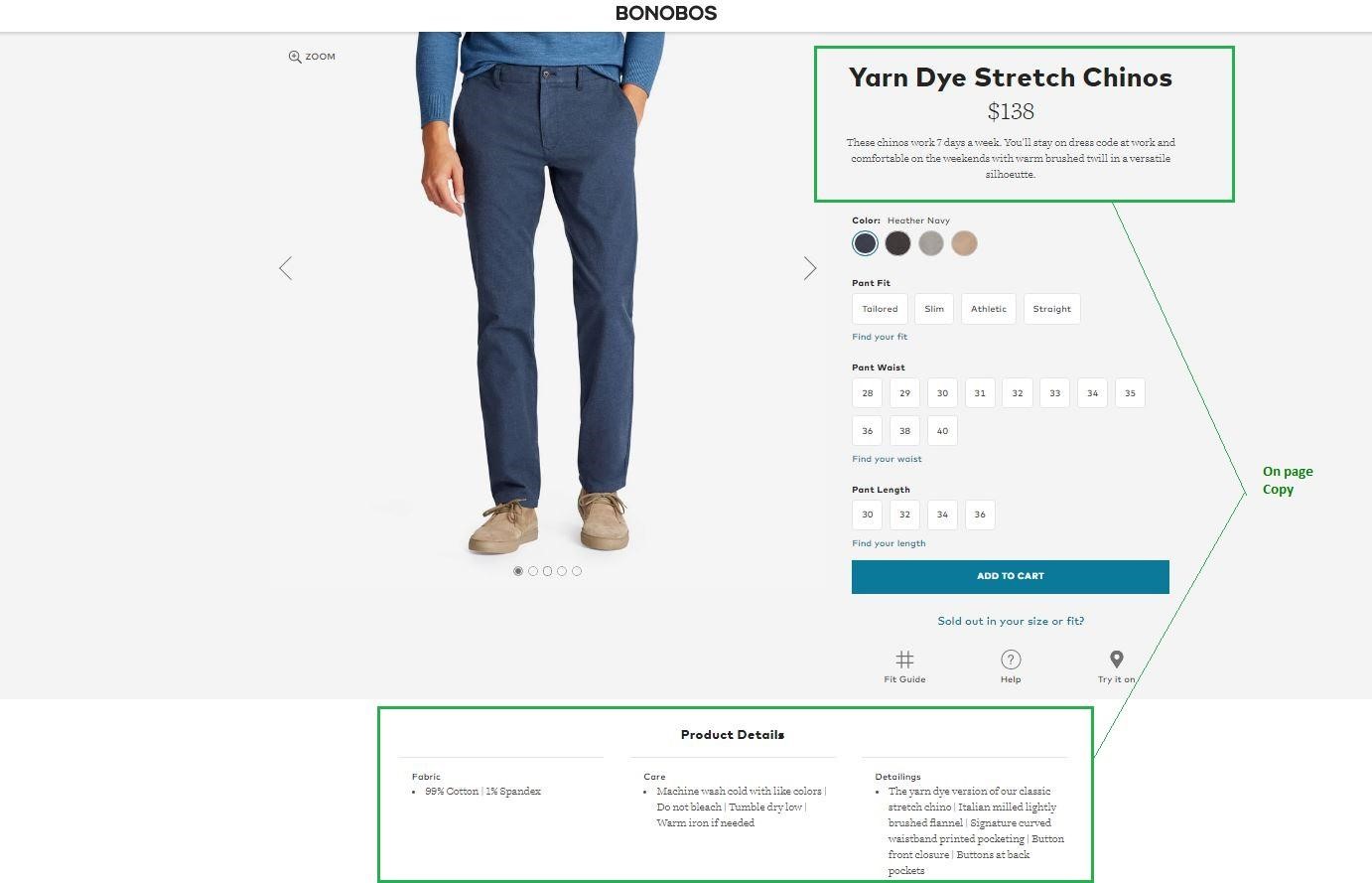
Marketing with meta descriptions
Your meta descriptions are not crawled by search engine bots, so they do not help your page appear higher in search results.
So why do we recommend optimizing these sections?
While meta descriptions do not impact SEO, they can help improve click through rates.
Think of your customer’s journey. After they input a search term, they are presented with a results page. Once they scan the title tags, they may look to the meta descriptions for more information. This is the perfect place to add compelling details that may not fit in the title tag.
PACT Apparel does this well, frontloading with their free shipping and returns policy and ending with a double whammy: a nod to their Fair Trade Certified product and a description of how comfortable the leggings are, both relevant details for their target audience.

Some parting wisdom
A few tips to keep in mind:
- DO speak human: Everything from your title tags to your product copy should read naturally.
- DO stand out: Meta descriptions and title tags are your first chance to snag customer attention.
- DON’T keyword stuff: Keywords need to be relevant to the page and used in context.
The goal is to optimize all your product and category pages. But, if you have a large catalog, that may not be an option. In that case, focus on optimizing 50-100 of your top selling products and category pages.
And there you have it! A quick-start guide to optimizing your ecommerce site, so you can improve your chances of showing up in search results and connecting with more qualified buyers.
Want your ecommerce store to appear higher in search? Get in touch with our team of digital marketing experts today!


